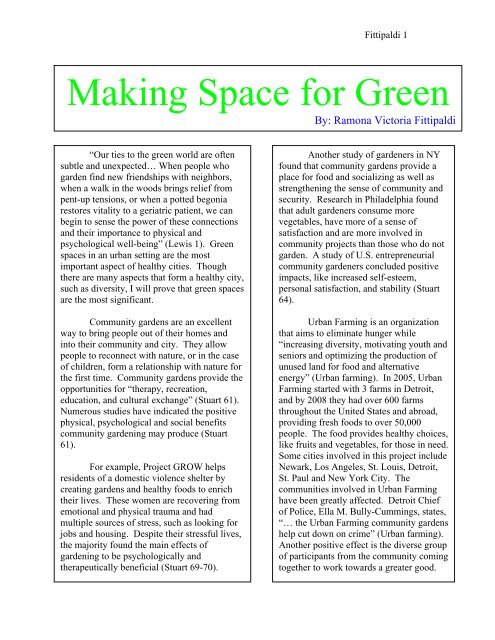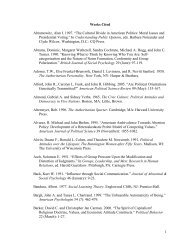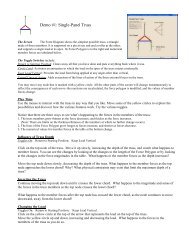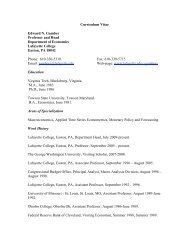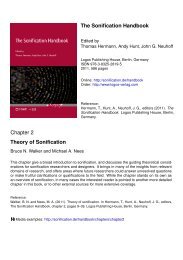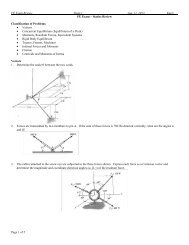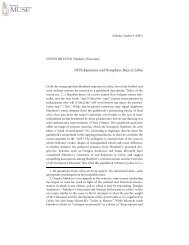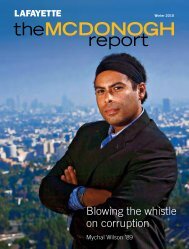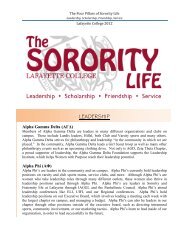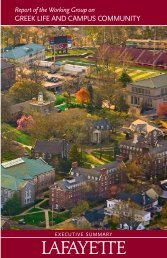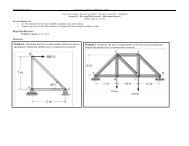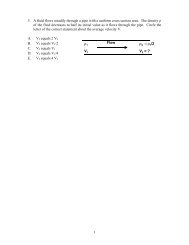Making Space for Green - Sites at Lafayette
Making Space for Green - Sites at Lafayette
Making Space for Green - Sites at Lafayette
Create successful ePaper yourself
Turn your PDF publications into a flip-book with our unique Google optimized e-Paper software.
Fittipaldi 1<strong>Making</strong> <strong>Space</strong> <strong>for</strong> <strong>Green</strong>By: Ramona Victoria Fittipaldi“Our ties to the green world are oftensubtle and unexpected… When people whogarden find new friendships with neighbors,when a walk in the woods brings relief frompent-up tensions, or when a potted begoniarestores vitality to a geri<strong>at</strong>ric p<strong>at</strong>ient, we canbegin to sense the power of these connectionsand their importance to physical andpsychological well-being” (Lewis 1). <strong>Green</strong>spaces in an urban setting are the mostimportant aspect of healthy cities. Thoughthere are many aspects th<strong>at</strong> <strong>for</strong>m a healthy city,such as diversity, I will prove th<strong>at</strong> green spacesare the most significant.Community gardens are an excellentway to bring people out of their homes andinto their community and city. They allowpeople to reconnect with n<strong>at</strong>ure, or in the caseof children, <strong>for</strong>m a rel<strong>at</strong>ionship with n<strong>at</strong>ure <strong>for</strong>the first time. Community gardens provide theopportunities <strong>for</strong> “therapy, recre<strong>at</strong>ion,educ<strong>at</strong>ion, and cultural exchange” (Stuart 61).Numerous studies have indic<strong>at</strong>ed the positivephysical, psychological and social benefitscommunity gardening may produce (Stuart61).For example, Project GROW helpsresidents of a domestic violence shelter bycre<strong>at</strong>ing gardens and healthy foods to enrichtheir lives. These women are recovering fromemotional and physical trauma and hadmultiple sources of stress, such as looking <strong>for</strong>jobs and housing. Despite their stressful lives,the majority found the main effects ofgardening to be psychologically andtherapeutically beneficial (Stuart 69-70).Another study of gardeners in NYfound th<strong>at</strong> community gardens provide aplace <strong>for</strong> food and socializing as well asstrengthening the sense of community andsecurity. Research in Philadelphia foundth<strong>at</strong> adult gardeners consume morevegetables, have more of a sense ofs<strong>at</strong>isfaction and are more involved incommunity projects than those who do notgarden. A study of U.S. entrepreneurialcommunity gardeners concluded positiveimpacts, like increased self-esteem,personal s<strong>at</strong>isfaction, and stability (Stuart64).Urban Farming is an organiz<strong>at</strong>ionth<strong>at</strong> aims to elimin<strong>at</strong>e hunger while“increasing diversity, motiv<strong>at</strong>ing youth andseniors and optimizing the production ofunused land <strong>for</strong> food and altern<strong>at</strong>iveenergy” (Urban farming). In 2005, UrbanFarming started with 3 farms in Detroit,and by 2008 they had over 600 farmsthroughout the United St<strong>at</strong>es and abroad,providing fresh foods to over 50,000people. The food provides healthy choices,like fruits and vegetables, <strong>for</strong> those in need.Some cities involved in this project includeNewark, Los Angeles, St. Louis, Detroit,St. Paul and New York City. Thecommunities involved in Urban Farminghave been gre<strong>at</strong>ly affected. Detroit Chiefof Police, Ella M. Bully-Cummings, st<strong>at</strong>es,“… the Urban Farming community gardenshelp cut down on crime” (Urban farming).Another positive effect is the diverse groupof participants from the community comingtogether to work towards a gre<strong>at</strong>er good.
Fittipaldi 2For example, in The Harlem district of NewYork City, Blacks, Whites, Asians andHispanics, both young and old, are workingon farms. The community members arecommunic<strong>at</strong>ing more and <strong>for</strong>mingfriendships while reconnecting to the earth(Urban farming).Joshua Palmer, the owner of SetteLuna, chooses his food carefully andchanges the menu to focus on foodsth<strong>at</strong> are in season, to allow his food tobe extremely fresh. Palmer st<strong>at</strong>ed th<strong>at</strong>buying local, fresh ingredients makes adifference in the taste of his food. Heenjoys being able to talk with theproducers of the foods and finds thefarmers’ market a gre<strong>at</strong> way tosocialize, as do others (Palmer).Farmers’ markets are a wonderful wayto interact with other communitymembers, while making healthy foodchoices.(Photo by Jennie Love)“Food production and consumptionhave lost their interconnectedness withn<strong>at</strong>ure” (Andre<strong>at</strong>ta 123). Several ef<strong>for</strong>ts,such as community gardens and directmarketing of fresh farm products, are helpingto restore the urban connection toagriculture. Farmers are selling directly tothe local public <strong>at</strong> roadside stands andfarmers’ markets. Removing the middlemenkeeps money within the area and provides asense of security and connection (Andre<strong>at</strong>ta123). Consumers now know where theirfood was produced and are able to askspecific questions regarding how. They areable to question whether it “is organic?” andif “there any pesticides used?” (Edens LosAngeles Sample). Children also becomemore aware of where their food originallycomes from and no longer think th<strong>at</strong> it comesfrom the grocery store (Edens Los AngelesSample). For instance the restaurant SetteLuna buys from Easton’s Farmers’ Market.(Photo by Ken White)Farmers’ markets andcommunity gardens have a range ofpositive outcomes on its residents, asdo street trees in a community. Kuo,Sullivan and their associ<strong>at</strong>es cre<strong>at</strong>ed aseries of studies th<strong>at</strong> compared publichousing residents based on theavailability of nearby n<strong>at</strong>ure, such asstreet trees and lawns. The studiesfound the following as advantages toresidents with nearby n<strong>at</strong>ure:* “more social interaction among youthand adults;* gre<strong>at</strong>er sense of community amongolder adults;
Fittipaldi 3* gre<strong>at</strong>er sense of safety and feeling ofbelonging;* better ability to cope with challenges;* lower level of fears, fewer incivilities, andless aggressive and violent behavior;* less chronic mental f<strong>at</strong>igue, which meansless likely to be impulsive andirritable;* gre<strong>at</strong>er self-discipline and ability toconcentr<strong>at</strong>e on the part of girls”(Kaplan 281-282).Trees draw residents from their nearbyhomes further into their community, wherethey get to know their neighbors. As theybecome more familiar with theirenvironment and neighbors, residents build astrong sense of trust and togetherness. It’sremarkable wh<strong>at</strong> a few street trees and lawnscan do <strong>for</strong> a community’s health (Kaplan281-282).I have experienced the effects ofstreet trees, first hand, by going on “JaneWalks.” Jane Jacobs was an urban activistand writer. She used her observ<strong>at</strong>ions ofcities and her common sense to demonstr<strong>at</strong>ewhy certain places in a city worked and wh<strong>at</strong>steps could be done to improve those th<strong>at</strong> didnot (“Jane Jacobs”). Jane Jacobs describedJane Walks as a “ballet of the good citysidewalk” (Russell). The street ballet is “anorder composed of movement and change,”where everyone who goes, by plays“distinctive parts, which miraculouslyrein<strong>for</strong>ce each other and compose an orderlywhole” (Russell). As I walked through thecity streets of Philadelphia and Easton duringmy Jane Walks, there was a noticeabledistinction between the streets with trees andthose without. Those with trees were moreinviting to pedestrians and gave a sense ofsafety. These streets cre<strong>at</strong>ed a friendly<strong>at</strong>mosphere and were more <strong>at</strong>tractive than theones without trees.Which street would you prefer towalk down?Which cre<strong>at</strong>es a safer, friendlier,more inviting <strong>at</strong>mosphere?(Photos by Ramona Fittipaldi)
Fittipaldi 4Street trees go beyond beautifying thecity; they lessen the effects of urbaniz<strong>at</strong>ionon the environment. Furthermore in thesummertime, they reduce the air temper<strong>at</strong>ureand harmful effects of storm w<strong>at</strong>er runoff.Street trees provide oxygen, as well ashabit<strong>at</strong>s <strong>for</strong> birds, insects, and other smallanimals. They cre<strong>at</strong>e a healthier urbanenvironment <strong>for</strong> people as well as lands(Mylon 22-23).Urban parks, especially those withn<strong>at</strong>ure and trees, stimul<strong>at</strong>e social interactionand physical activities, when the communityfeels safe in them. Parks in “mixed-useneighborhoods” thrive because there is aassortment of buildings, which produce <strong>for</strong>the parks a mixture of users, who enter andleave the parks <strong>at</strong> different times (Frumkin255). These parks are a safe place and cre<strong>at</strong>ean <strong>at</strong>mosphere <strong>for</strong> socializing, relax<strong>at</strong>ion,reflection, and physical activity. Parksencourage physical activity outside in n<strong>at</strong>ure,which is important because many urgentphysical health rel<strong>at</strong>ed problems areconnected to inactive, indoor urbanlifestyles. Exercise is now known to be a“codeterminant of health” (Barlett 308).Physical activity decreases the risk of dyingfrom heart disease and reduces the risk ofdeveloping diabetes, hypertension, and coloncancer. It cre<strong>at</strong>es healthy muscles and bones,helps maintain independence in the elderly,and has an influence on people’s sense ofwell-being (Barlett 300-308). Consequently,parks provide a diverse range of roles,including trails <strong>for</strong> n<strong>at</strong>ure walks andbicycling, peaceful areas <strong>for</strong> reading, andrecre<strong>at</strong>ional facilities. There are a gre<strong>at</strong>variety of parks, such as small urban pocketparks and w<strong>at</strong>erfronts (Frumkin 261-262).W<strong>at</strong>erfront parks provide additional facilities<strong>for</strong> physical activities, such as kayaking,canoeing and bo<strong>at</strong>ing (Mylon 19).(“The Top 3 Most Popular New York CityAttractions”)At times, it can be “difficult tosurvive cold urban life” with little moneyand unfriendly crowds (Ledden).However, green spaces relieve stress andpromote physical activity and socializing.Ultim<strong>at</strong>ely, they address the physical andmental aspects of community members’health. With health a primary issue <strong>for</strong>most people, <strong>for</strong>ming a healthy city shouldbegin with the development and furtherutiliz<strong>at</strong>ion of green spaces.Works CitedAndre<strong>at</strong>ta, Susan. “Urban Connections toLocally Grown Produce.” UrbanPlace: Reconnecting with the N<strong>at</strong>uralWorld. Ed. Barlett, Peggy.Cambridge: The MIT Press, 2005.117-140.Barlett, Peggy, ed. Urban Place:Reconnecting with the N<strong>at</strong>uralWorld. Cambridge: The MITPress, 2005.
Fittipaldi 5Edens Los Angeles Sample. PBS miniseries: Edens Lost and Found. 2007..Frumkin, Howard. “The Health of Places,the Wealth of Evidence.” UrbanPlace: Reconnecting with the N<strong>at</strong>uralWorld. Ed. Barlett, Peggy.Cambridge: The MIT Press, 2005.253-269.“Jane Jacobs.” Project <strong>for</strong> Public <strong>Space</strong>.2008. 6 March 2009..Kaplan, Rachel, and Stephen Kaplan.“Preference, Restor<strong>at</strong>ion, andMeaningful Action in theContext of Nearby N<strong>at</strong>ure.” UrbanPlace: Reconnecting with the N<strong>at</strong>uralWorld. Ed. Barlett, Peggy.Cambridge: The MIT Press, 2005.271-298.Ledden, Alicia Kong, and Hanna Soll-Morris. “Ecoart 08: SIoux Maq.”2008. 6 March 2009.< http://www.ecoart08.blogspot.com/>.Love, Jennie. “Urban + Farming=Oxymoron?” E<strong>at</strong>.Drink.Better..Mylon, Steven, Arthur Kney, LaurieCaslake, and Javad Tavakol.Urban Ecology in the WestWard. <strong>Lafayette</strong> TechnologyClinic, 2008.Palmer, Joshua. “Sette Luna Salon.”Sette Luna. 10 February 2009.Russell, James. “Jane Jacobs’ Lesson:Look and Learn.” 2006. 6 March2009. .Stuart, Susan. “Lifting Spirits: Cre<strong>at</strong>ingGardens in Cali<strong>for</strong>nia DomesticViolence Shelters.” Urban Place:Reconnecting with the N<strong>at</strong>uralWorld. Ed. Barlett, Peggy.Cambridge: The MIT Press, 2005.61-88.“The Top 3 Most Popular New York CityAttractions.”.Urban Farming. Aidan Brooks. 2008. .White, Ken. “Two weeks left to enjoyEaston Farmers' Market.”.Lewis, Charles. “<strong>Green</strong> N<strong>at</strong>ure/ HumanN<strong>at</strong>ure.” Urban Place: Reconnectingwith the N<strong>at</strong>ural World. Ed. Barlett,Peggy. Cambridge: The MIT Press,2005. 1.


